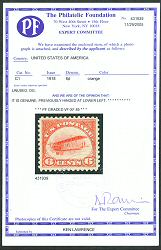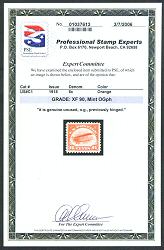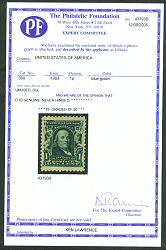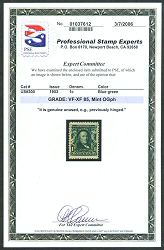
 |
A Dissenting Expert Opinion on Graded Certificates
By Ken Lawrence
July 2007
Numerical grading of stamps, introduced in 2001 by Professional Stamp Experts (PSE) and now also offered by the Philatelic Foundation (PF), is not good for our hobby. The American Philatelic Expertizing Service (APEX) does not issue graded certificates at this time, although many APS members have urged a switch to grading.
APEX is a service of the American Philatelic Society (APS), which has certified and authenticated stamps since 1903. PF was chartered in 1945 by the University of the State of New York as a Nonprofit Educational Institution. Both APEX and PF are tax-exempt not-for-profit services.
PSE, which has gone through restructuring and ownership changes since stamp dealer J. Randall Shoemaker began the business in 1984 as Professional Stamp Grading Service, is a commercial enterprise owned by Collectors Universe Inc., a publicly traded company. PSE advertises itself as a "value added" grading service. In my opinion that's where the problem begins.
As an expertizer, I don't want my opinion to be influenced by the potential value of a stamp or cover I'm examining. My job is to determine whether the item is properly or improperly identified, properly or improperly described, sound or faulty, and in its original condition or altered. Whether the item is common or rare, cheap or expensive should not affect my expert examination and opinion, and I should not be trying to enhance its value in the marketplace.
Calculating the Grade
According to an article in the April 2007 Scott Stamp Monthly, both PSE and PF grade stamps by taking precision measurements at eight points on the margins of each stamp, two points on each side, and then calculating the excellence of centering from those measurements. I haven't any interest in calculating the visual symmetry of a stamp; I would quit expertizing if I were required to take measurements for that purpose.
Besides being a misuse of experts' time, at best, and a distraction from the important duties of experts', at worst, taking time to perform these labor-intensive measurements and calculations adds precious time to the expertizing procedure.
The biggest complaint that customers express about expert committees is the time required to certify a stamp, typically 45 to 60 days. We all constantly strive to reduce "turn-around time" without sacrificing quality and without making mistakes. Adding a step that does nothing to improve the accuracy of an expert's real job is not a good use of his time in my opinion.
Numerical Grading is Inconsistent
At the most fundamental level, numerical grading is misleading because it implies a degree of precision in ranking the relative desirability of stamps that is illusory. The terms we have always used to describe how well or poorly stamps are centered - average, fine, fine to very fine, very fine, extremely fine, and superb - have served us well for generations. Unlike numeric grades, those traditional terms do not imply that every stamp of a specific grade is fungible (interchangeable in the market with another of the same grade).
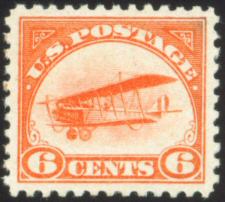 To illustrate the difference, consider the Figure 1 stamp (right - click for a larger view), an attractive 6¢ orange Curtiss Jenny air mail stamp of 1918, Scott C1. I purchased it about two years ago from a seller on the eBay auction Internet website, advertised as graded XF 90 by PSE. Judging by the image on my computer screen, it appeared to be centered a bit high, and the uneven side perforations with traces of a guide line at the left made estimating the horizontal centering tricky. It did not seem like a stamp I'd have described as exceedingly fine, but I wanted to see for myself, so I paid the premium price.
To illustrate the difference, consider the Figure 1 stamp (right - click for a larger view), an attractive 6¢ orange Curtiss Jenny air mail stamp of 1918, Scott C1. I purchased it about two years ago from a seller on the eBay auction Internet website, advertised as graded XF 90 by PSE. Judging by the image on my computer screen, it appeared to be centered a bit high, and the uneven side perforations with traces of a guide line at the left made estimating the horizontal centering tricky. It did not seem like a stamp I'd have described as exceedingly fine, but I wanted to see for myself, so I paid the premium price.
PSE certificate number 01019498 dated September 2, 2005, matched the eBay description for the stamp: "XF 90, Mint OGph" (original gum, previously hinged). I showed the stamp to two experienced dealers who sell PSE graded stamps, and asked each of them to estimate the grade. Both of them said it deserved a grade of 85, and were surprised when I showed them the PSE certificate.
Next I submitted the stamp to the PF for a graded opinion. The November 29, 2005, certificate stated: "PF GRADED VF-XF 85," which agreed with the two dealers and disagreed with PSE's opinion. Thinking that perhaps PSE's graders had made a mistake, I sought a new PSE opinion, but certificate number 01037613 issued March 7, 2006, matched the original opinion: "XF 90, Mint OGph." The PSE and PF certificates for this stamp are illustrated below (click for a large view).
It's important to add that this stamp has no extraordinary aspects to enhance its visual appeal. The color is not exceptional, and by the time PSE reexamined it, the upper right corner of the design had begun to darken, a process called sulfurization that afflicts orange ink causing it to turn brown or black.
The April-June 2006 issue of PSE's Stamp Market Quarterly (SMQ), which I consulted after I had secured both opinions, priced a previously hinged Scott C1 stamp graded VF-XF 85 at $80, and one graded XF 90 at $100. If a buyer were to rely on the graded certificate as a guide to value, the PSE certificate would have increased the value by 25 percent over the PF certificate, which is not an insignificant amount.
Multiple Discrepancies in Grading
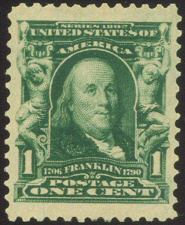 I did not want my skeptical study of graded certificates to rely on one example, so I submitted a 1¢ green Benjamin Franklin sheet stamp of the 1902 Series shown right (click for a larger view), Scott 300, for PSE and PF at the same time. Stamps of this series are not easy to find with excellent centering and even margins. The frames are not rectangular; elements of the designs protrude into the side border areas. This example had the best centering I had found.
I did not want my skeptical study of graded certificates to rely on one example, so I submitted a 1¢ green Benjamin Franklin sheet stamp of the 1902 Series shown right (click for a larger view), Scott 300, for PSE and PF at the same time. Stamps of this series are not easy to find with excellent centering and even margins. The frames are not rectangular; elements of the designs protrude into the side border areas. This example had the best centering I had found.On this stamp, the results were even more surprising. It came back "VF-XF 85, Mint OGph" from PSE; and "PF GRADED XF 90" but "NEVER HINGED." The difference in value between a never-hinged stamp and a previously-hinged stamp is far greater than the difference in value between the two grades.
Both certificates are shown below. It's always unfortunate when experts fail to agree on gum condition, but it does happen sometimes. Here I want to keep my focus on the subject of numerical grading. On this stamp, the experienced dealers I consulted diverged even more than the two expert committees. One guessed that my stamp would grade 75; the other guessed 90.
Using the then-current SMQ values for Scott 300 in never-hinged condition, grade 85 was worth $60 and grade 90 was worth $115, so the PF certificate valued my stamp almost 92 percent higher than PSE if both had agreed on the gum. As previously hinged, the values were $17 and $25, respectively, a significant difference, but less than the cost of certifying the stamp.
In the first instance, PSE assigned a higher grade; in the second case, PF did. These two examples are not sufficient to prove that discrepancies are common, but they do demonstrate that the precision implied by the numbers cannot be achieved. An unscrupulous seller seeking the highest return would advertise only the higher grade for each stamp, which defeats the alleged purpose of graded certificates.
Fraudulently Enhanced Centering
Another problem is even worse, and can be demonstrated by one of my certified stamps. I had not taken time to expertise my 1¢ Franklin stamp before submitting it to PSE and PF. I assumed it was genuine, sound, and in its original condition. But the enlarged photograph on the PF certificate revealed traces of green ink at the tips of some bottom perforations. Under magnification it was clear that these were remnants of a guide line. On 400-subject printed sheets of Scott 300, stamps were quartered into panes of 100 by being cut along the horizontal and vertical guide lines as they passed through the perforator.
The presence of a guide line at the bottom indicated the location of a straight edge, which meant that the bottom perforations had been added. Whoever reperforated this stamp was skilled at altering stamps; the diameter and spacing of the holes measure exactly right on a United States Specialist Gauge. But reperforating is an alteration that should be noted on the certificates.
I hasten to add that any expert might have missed this alteration, but I think the tedious requirements of taking measurements for grading calculations may have distracted the experts' attention from more fundamental tasks. Meanwhile, soaring demand for common stamps with perfect or near-perfect symmetry provides an incentive for skilled fakers to enhance stamps by reperforating them.
For more than five years, PSE gave numerical grades to reperforated stamps. On May 7 of this year, PSE changed its policy and announced that it had discontinued the grading of stamps deemed to be reperforated: "Since reperforation is a deliberate alteration, such must be considered considerably more egregious than accidental faults such as creases, tears or thins."
Centering Isn't Always Most Important
Those are my principal objections to graded certificates, but they are not the only ones. An exchange between reader Rob Friedman and catalog editor Jim Kloetzel in the June 2007 issue of Scott Stamp Monthly discussed the problem of grading bicolor stamps on which one color is not in good register with the other, an aspect that graded certificates had not taken into account.
Since 1981, plate number coil collectors and dealers have used different standards to describe mint strips. For engraved stamps printed on Cottrell presses, placement of a joint line along the perforation row determines its grade, not the placement of the stamp design. If the line fails to touch the perforations, the grade is "average." If the line barely touches, it is "fine." Continuing the logic, a "superb" strip has the joint line exactly centered on the perforation row. To be collectible by these standards, vertical placement must leave unprinted margins below the plate number and above the design, but perfect symmetry is not required.
For imperforate stamps, an owner who doesn't mind mutilating all the stamps surrounding the one to be graded can easily achieve the highest possible grade, but by what collecting standard should that practice be encouraged?
Coin Grading Experience
Michael Sherman, president of PSE, says that PSE's grading system is bringing the blessings of coin grading to stamp collecting. The introduction of grading in 1976, and standardization of a uniform grading system and encapsulation of coins within a decade, facilitated sight-unseen trading in the marketplace.
While it's true that grading has transformed coin collecting, not all the changes have been positive. Some of the negative experiences ought to serve as a warning to stamp collectors.
By 1989, encapsulated graded coins were being promoted as investments. Large Wall Street brokerages created rare coin funds, believing that standardized grading reduced the risk to investors who were not knowledgeable about coins. But charges filed by the Federal Trade Commission revealed that the system was fraught with abuse.
The FTC's annual report for 1989 stated, "A complaint was filed in federal district court challenging Certified Rare Coin Galleries with deceptively marketing purportedly rare coins as low-risk, liquid, high-yield investments. The court issued a temporary restraining order with an asset freeze and appointed a receiver for Certified.
"Numismatic Certification Institute, and its principals, Steve Ivy and James Halperin, agreed to settle charges that its representations and failures to disclose information misled consumers as to the values of coins certified by the company. An affiliate, Heritage Capital Corporation, also agreed to settle charges that it provided substantial assistance to a coin retailer, Certified Rare Coin Galleries (CRCG), knowing that CRCG was misrepresenting the security and profit potential of its coins to investors. Under the settlement, defendants agreed to a permanent injunction, and Heritage and NCI agreed to contribute $1.2 million into a consumer redress plan for CRCG's customers."
The following year's report was worse: "In fiscal year 1990 approximately $19.5 million in consumer redress was ordered in cases involving investment fraud. The Commission obtained settlements containing judgments of over $15 million for distribution to customers of companies charged with falsely representing the grading and/or value of rare coins."
The FTC complaint against Professional Coin Grading Service alleged that PCGS failed to provide "objective or consistent grading" and that "PCGS does not in all cases observe its 'strict anti-self interest policy'." The FTC obtained a permanent injunction against PCGS that prohibited the company from making false representations about its objectivity and consistency, or about the liquidity of its coins, and prohibited PCGS from making deceptive statements about the risks of investing in graded coins.
PCGS did not admit wrongdoing, but agreed to submit its advertising to the FTC for review for a period of five years. In a filing in Federal district court in Washington, the company agreed to include a statement in its newspaper and television advertising affirming that certification by PCGS does not guarantee protection to investors.
Even though the worst abuses were curtailed by FTC action, uniform objective grading has not been realized. In 2003 Coin World magazine tested the eight major coin grading services by sending 15 United States coins to each. In every case, the same coins received different grades from different services. In some cases grades were several points apart, and in some instances two or more services differed over whether a coin had been "cleaned" (chemically enhanced).
The Future of Stamp Grading
Stamp grading is a quarter-century younger than the current system of coin grading, and at present the federal regulatory climate is in a lax phase, but collectors and dealers would be wise to take note of the numismatic experience and to act now to prevent our hobby from stepping into the same snares.
Potential conflicts of interest are abundant, despite PSE's and PF's attempts to assure that their opinions are objective and impartial. PF's board of directors, which sets policy for the foundation, includes several of the major dealers who make markets in graded stamps.
A dozen dealers and half a dozen auction firms that make markets in stamps graded by PSE are promoted on PSE's website, which includes direct links to most of those sellers. A "Dealer Financing" tab links to another Collectors Universe subsidiary, Collectors Finance Corporation, which offers business loans on PSE-graded stamps for up to half of the value published in PSE's SMQ publication.
In his Scott Stamp Monthly article on grading, Jim Kloetzel wrote, "One of my current personal amusements is reading auction lot descriptions of graded stamps in which the auction house disagrees with the grade assigned by PSE or the PF." That would not be so amusing to read if the author of the lot description is a PF board member or a PSE favored dealer, quoted in a Federal Trade Commission complaint.
Kloetzel named Charles Shreve as the "strongest voice in recent months" in favor of stamp grading. Yet Shreves Philatelic Galleries' terms of sale state in bold type, "No lot may be returned due to a certification service grading a stamp differently than the grade stated in the auction description." (No major auction firm recognizes a conflicting grade on a PSE or PF certificate as grounds for return.)
Before we travel too far down this road, I'd like to see a more comprehensive comparative test of PF and PSE grading than I was able to do, similar to Coin World's test of coin grading services, to see whether the disparities in my two examples are representative of a problem or if grading is more consistent than I believe.
Final Observation
It's possible that stamp grading may collapse on its own, without undergoing an ordeal comparable to the coin grading scandals of 1989 and 1990. Even before numerical grading was introduced, grading of coins by condition always occupied greater prominence in numismatics than in philately, with scholarly books and seminars dedicated to that subject alone.
Judging by Collectors Universe annual and quarterly reports to investors, PSE's stamp grading business may be faltering even as its volume grows. In fiscal year 2004, PSE graded 16,000 stamps valued at $10 million, an average value of $625 per stamp. In FY 2005, PSE graded 26,000 stamps valued at $17 million, increasing the average value to $653 per stamp. In FY 2006, PSE graded 38,000 stamps valued at $21 million, a decline to $552.63 per stamp.
But the first quarter of 2007, the most recent report available, shows a shocking decline from the 2006 level. For the three months ended March 31, 2006, PSE graded 10,000 stamps valued at $5.43 million, an average at $543 per stamp, but for the comparable period ended March 31, 2007, the volume was up to 16,900 stamps but the declared value was down to $3.077 million, an average of just $182.07.
At that rate the stamps being submitted are scarcely worth being expertized. It suggests that stamp grading has become a lottery, with collectors and dealers rummaging through piles of inexpensive stamps in hopes of finding some that will score 98 to 100. If it really comes to that, the end may come sooner than anyone expects.
Ken Lawrence is an expertizer for the American Philatelic Society's APEX service and an expertizing consultant for the Philatelic Foundation. The opinions expressed in this article are his, and do necessarily not reflect the policy of any organization or expert committee.
